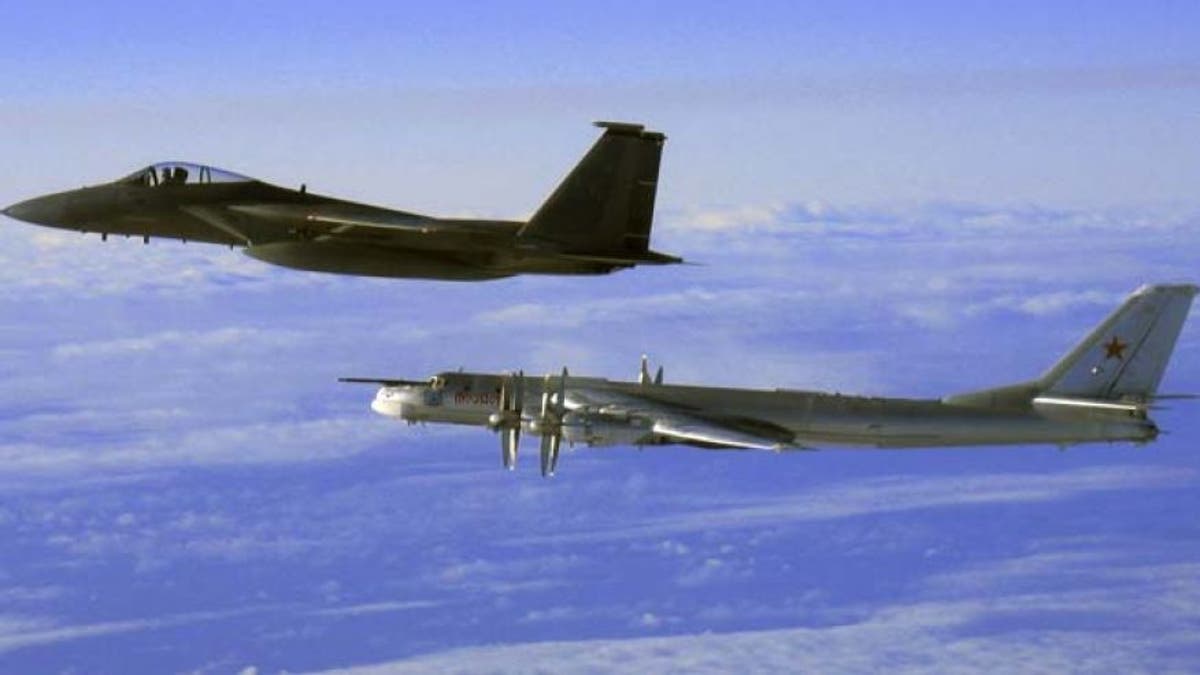
Sept. 28, 2006: This file photo provided by the U.S. Air Force shows an F-15C Eagle from the 12th Fighter Squadron at Elmendorf Air Force Base in Anchorage, Alaska, flying next to a Russian Tu-95 "Bear" bomber, right, during a Russian exercise which brought the bomber near the west coast of Alaska. (AP/US Air Force)
Photographs of NATO fighter jets monitoring Russian military aircraft as they approached the airspace of NATO countries in recent months revealed more than just President Putin flexing his muscles in response to sanctions against Russia for its support of Ukrainian separatist rebels. They also indicate that Russian bomber technology from the 1950s was built to last, perhaps for far longer than many anticipated. The appearance of the veteran Soviet long range nuclear-capable bombers is however in stark contrast to the relative modernity of the high-tech American F-15, European Lightning, and other NATO fighter jets often scrambled to shadow them.
The Russian Tupolev Tu-95 bomber, assigned the codename "Bear" by NATO, was first flown in 1952, and entered service with the Soviet Air Force in the mid-1950s. It is doubtful many of those who designed and built the first examples of the Tu-95 Bear anticipated it would still be operating a front line role in the Russian Air Force some 60 years later.
Like its American Cold War era counterpart, the Boeing B-52 Stratofortress, the Tu-95 continues in a front-line operational role while several subsequent iterations of bomber designs have come into service in the Russian and American air forces, and others have come and gone.
One significant reason the Tu-95 Bear and Boeing B-52 Stratofortress behemoths of Cold War air power have stuck around for so long is that they have proven very adaptable airframes, suitable for modification to perform a number of different roles. These have included air-launch platforms for modern cruise missiles, long range maritime patrol, and use as an airborne radar platform.
Both the Tu-95 Bear and Boeing B-52 Stratofortress had originally been brought into service as strategic long-range bombers designed to drop free-fall nuclear bombs on static enemy targets, including military bases and population centers.
The prototype B-52 with its eight turbojet engines, made its maiden flight in 1952 before going into active service with the U.S. Air Force in 1955. In the region of 80 B-52’s remain in service with the U.S. Air Force, now under Air Force Global Strike Command (AFGSC). In addition to its large payload and flexibility as a weapon-carrying platform, the relatively low operating costs of the B-52 in comparison to some of the alternatives developed later continue to make the aircraft a practical option for U.S. commanders and Air Force budget planners.
The longevity of front line active service of the B-52 and the Tu-95 is unlikely to be matched by many other aircraft. Since it came into service in the mid-1950s the Tu95 Bear has proved a nuclear capable weapon of concern to 11 U.S. Presidents, from Dwight D. Eisenhower to Barack Obama, the current President being born five or so years after the Tu-95 first entered operational service with the Soviet Air Force. By the time the Tu-95 is scheduled to be retired from active service in 2040 it could theoretically provide concern for another seven future U.S. Presidents.
